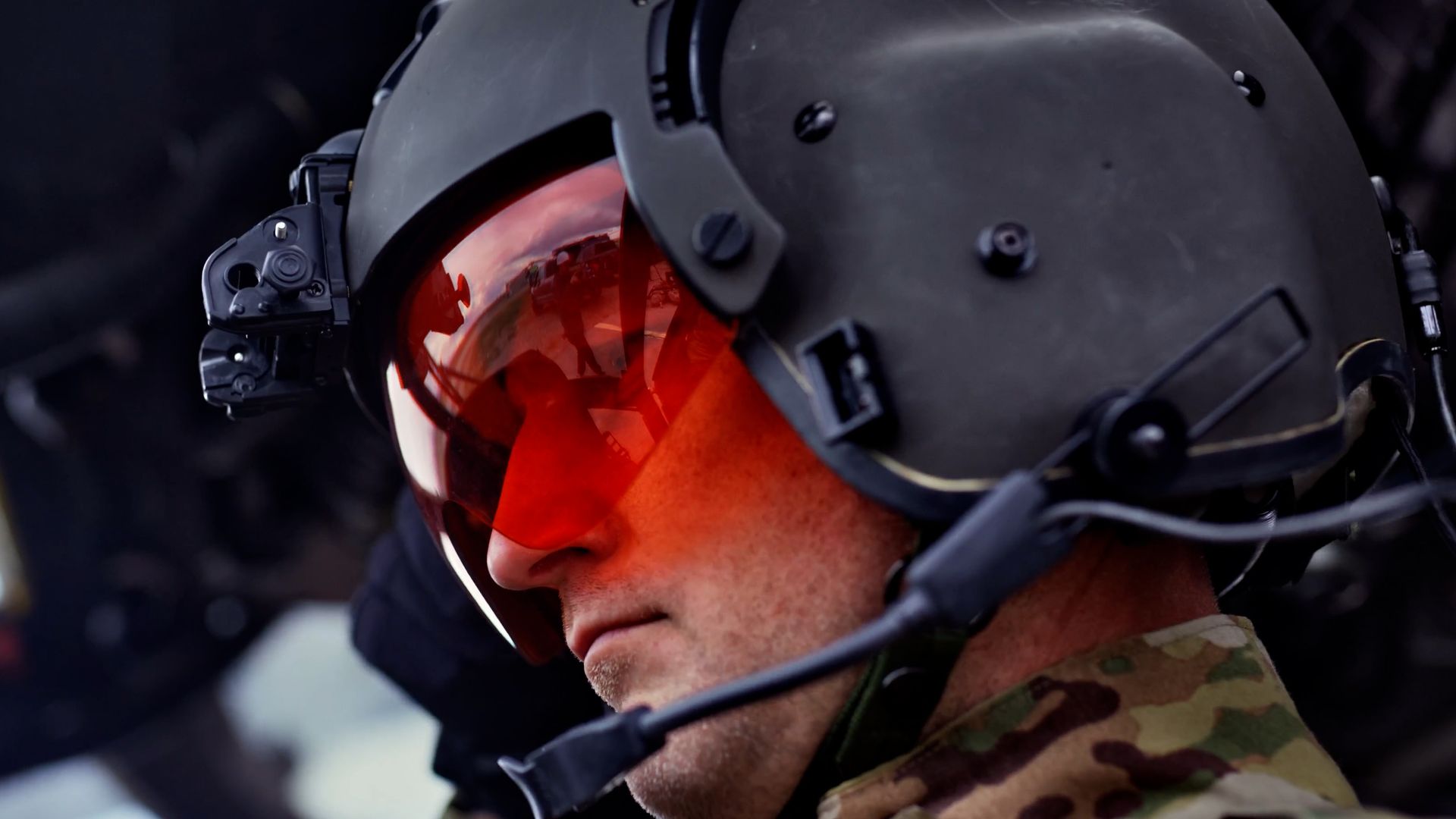
[RYAN ROBERTSON] ALL RIGHT, FOLKS FOR THIS WEEK’S WEAPON OF THE WEEK. WE’RE GOING TO BE TALKING ABOUT HELMETS THAT THE ARMY USES, AND JOINING ME NOW TO TALK ABOUT THOSE IS [MARCUS GENGLER] WITH GENTEX. [MARCUS], YOUR OFFICIAL TITLE, PLEASE.
[MARCUS GENGLER] “Yeah, I’m the director for road rowing applications here at Gentex.”
[RYAN ROBERTSON] THAT’S WHY I DIDN’T WANT TO SAY IT, BECAUSE IT’S A VERY LONG TITLE. SO [MARCUS], TALK TO ME ABOUT THESE HELMETS, OBVIOUSLY. GENTEX, YOU’VE BEEN MAKING HELMETS SINCE THE 40S, YOU HAVE THE GROUND HELMETS THAT MOST SOLDIERS ARE FAMILIAR WITH, BUT YOU GUYS ALSO HAVE OTHER HELMETS.
[MARCUS GENGLER] “We do. That’s right, that’s right. As you can see. You know, we specialize in, we have a very big segment now in the Special Operations helmet, but, but my segment happens to be Army Aviation. And, well, not just Army Aviation, but aviation in general, and so so we’ve created, we’ve made the the HG- 56/p now for about 30 plus years.”
[RYAN ROBERTSON] AND THIS IS SOMETHING THAT EVERY HELICOPTER PILOT IS FAMILIAR WITH.
[MARCUS GENGLER] “Every helicopter pilot that flies for the DoD is familiar with. This helmet. You know, the Army’s had it now for 30 years. The Navy is fielding it for their younger aviators, and the Marines, and the Navy, or assuming, the Marines in the Air Force have had this as well. What I did want to kind of focus on is that you’ll notice that the block three Apache helmet is now very similar to the HGU-56/p there was a unique helmet for this. When the Apache was first fielded, when they fielded the ECHO model Apache, we went to a standardized helmet. So the common design is the same. However, the uniqueness of this helmet is the fact that their heads, integrated heads up display, connects to this helmet in a unique way, very different than the standard 50 6p. and so therefore that that monocle comes up here sits at the eye of the aviator, so that he can fly from that the HGU-56/p like I said, has been around for many years and and we’re finally giving it a tech refresh. We’re calling it the lockdown liner and, and frankly, what that is for those that are of your audience that are familiar with these helmets, many times these teeth, the impact liner that’s been inside has been a one piece liner, many times a little uncomfortable. So we’ve now broken it up into three different distinct pieces that allow for some breathability and comfort, as well as a an octa dial here that allows for a more stable fit for the back of the nape strap. This should allow for those that fly with goggles or other head born devices to have a little bit more stable and more comfortable feel. And so we’re looking forward to fielding that sometime in 2025 and we’re really excited to show it here at the show.”
[RYAN ROBERTSON] SO HELICOPTER PILOTS HAVE SOME MORE COMFORT TO LOOK FORWARD TO. LAST LITTLE THING I WANT TO TALK TO YOU ABOUT, SURE YOU MENTIONED THE HEADS UP DISPLAY ON THE APACHE. HELL, THAT’S CORRECT. WHAT KIND OF INFORMATION ARE THEY ABLE TO SEE THAT YOU’RE ABLE TO PUT UP IN THAT HEADS UP DISPLAY?
[MARCUS GENGLER] “So the age 64 pilots today are able to take this, the image that’s being produced from their forward looking infrared as well as their day TV cameras, and they’re able to portray that information into their helmets. They use it for targeting purposes. Many of the gun footage that we’re familiar with is taken from the image that’s produced for that heads up display. So we’re very familiar with what it looks like. It also has data that allows the pilots to fly, so basically a rate of descent, rate of climb, you know, whether they’re in trim, air speed, altitude, those sorts of information is also available for them as well. And frankly, one of the biggest pushes, I think, for the army and in ARM aviation is to improve upon the Heads Up displays that are available for aviators. And so we partner a lot with our industry partners when it comes to heads up displays and heads up display technology, because much like an aircraft is a platform, we believe our helmet system is a platform with which other industry partners will use to put their their kit and capability on. So we’re excited to work with them.”
[RYAN ROBERTSON] MARCUS, THANK YOU SO MUCH FOR JOINING US TODAY.
[MARCUS GENGLER] “You’re welcome. Thank you so much for the time.”











